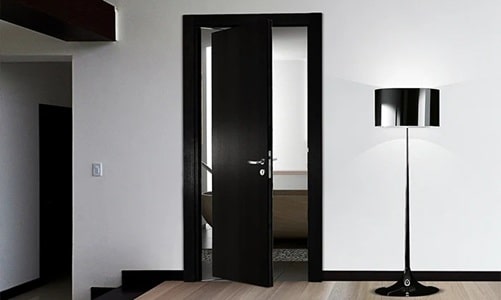Opening a door should be simple. Yet for millions of people, this everyday task creates unnecessary struggle. Traditional round doorknobs require tight gripping and twisting motions that strain hands and wrists. Ergonomic door hardware changes this reality by designing with human comfort and capability in mind.
Ergonomic hardware refers to door handles, levers, and systems specifically engineered to reduce physical effort while increasing ease of use. These designs prioritize natural hand movements and minimize strain on joints, making doors accessible to everyone regardless of age or physical ability.

Key Benefits of Ergonomic Door Hardware
Reduced physical strain ranks as the primary benefit of ergonomic hardware. Traditional handles create pressure points that lead to discomfort and fatigue, especially during repeated use. Ergonomic designs contour to hand shapes and distribute pressure evenly across larger surface areas. This prevents concentrated stress on fingers and wrists.
Enhanced safety represents another critical advantage. Smooth, controlled door operation prevents injuries from doors that slam shut unexpectedly. Soft close mechanisms gently slow doors during both opening and closing, reducing noise and protecting fingers from getting caught. These systems work on doors weighing up to 200 pounds while holding them securely in place when closed.
Universal accessibility extends beyond ADA compliance. Ergonomic hardware accommodates users of all ages and abilities. Children, elderly individuals, people with temporary injuries, and those carrying items all benefit from handles that require minimal effort. This inclusivity creates environments where everyone can move independently and confidently.
Improved home value follows naturally from these functional upgrades. According to industry experts, quality door hardware significantly impacts property appeal and resale value. Prospective buyers notice attention to detail in hardware choices. Modern, well functioning hardware signals that a home has been properly maintained. Premium materials like stainless steel and brass offer both durability and sophisticated aesthetics that attract discerning buyers.
Design Features That Enhance Performance
Several specific design elements define effective ergonomic hardware. Lever length matters significantly. Handles measuring 20 to 30 centimeters provide optimal leverage and comfortable reach. Longer levers require less force to operate while offering more surface area for various gripping methods.
Surface texture prevents slipping. Non slip finishes and contoured grips ensure secure contact even when hands are wet or when users have reduced grip strength. Many ergonomic handles incorporate textured patterns or rubberized coatings that enhance friction without feeling rough or uncomfortable.
Material selection influences both function and longevity. High quality materials like forged steel, solid brass, and aircraft grade aluminum provide strength without excessive weight. Italian manufacturers have built exceptional reputations for door hardware that combines premium materials with innovative engineering. These products undergo rigorous testing and often carry certifications for corrosion resistance and durability.
Installation height follows universal design principles. Mounting hardware between 85 and 110 centimeters accommodates the broadest range of users. This positioning works for standing adults, children, and wheelchair users alike. Consistent placement throughout a building reduces confusion and supports intuitive navigation.
Practical Applications Across Settings
Ergonomic door hardware proves valuable in every environment. Residential homes benefit from easier daily operation and enhanced safety for all family members. Parents appreciate hardware that children can operate independently. Aging in place becomes more feasible when homes incorporate accessible design elements.
Commercial buildings must meet ADA requirements while serving diverse populations. Offices, schools, hospitals, and retail spaces all need hardware that supports smooth traffic flow. Ergonomic designs reduce bottlenecks and accommodate people moving quickly or carrying items.
Healthcare facilities place special emphasis on hygiene and ease of use. Lever handles that operate without hand contact support infection control protocols. Silent operation from soft close mechanisms protects patient rest and recovery.
Choosing the Right Hardware for Your Needs
Selecting ergonomic hardware requires considering several factors. Start by assessing who will use the doors most frequently. Households with elderly residents or children should prioritize handles with minimal force requirements. Commercial spaces need durable options that withstand high traffic volumes.
Evaluate existing door systems to determine compatibility. Many ergonomic upgrades work with standard door preparations, making retrofits straightforward. For new construction or major renovations, consider integrated systems that combine sliding door system solutions with ergonomic hardware for maximum space efficiency and accessibility.
Material and finish choices should complement overall design aesthetics while providing long term performance. High quality barn door hardware combines rustic appeal with modern ergonomic features, creating both visual impact and functional excellence.
Making the Upgrade
Transitioning to ergonomic door hardware represents a practical investment in comfort, safety, and property value. The benefits extend to every person who interacts with your doors. Reduced strain prevents long term joint problems. Enhanced accessibility supports independence for people with varying abilities. Smooth, quiet operation improves daily living quality.
Ready to experience the difference ergonomic door hardware makes?
Milcasa Store offers premium Italian made door systems engineered for effortless operation. Their collection features concealed mechanisms, soft close technology, and designs that prioritize both aesthetics and accessibility. Explore their range of solutions to find hardware that transforms your space while supporting the needs of everyone who enters.
Hina Abbasi is Editor and a passionate sports and entertainment content writer at WinnersMaze.com. Hina’s expertise spans across a wide range of sports, and interest in many TV shows allowing her to deliver insightful analysis and compelling stories that resonate with readers.
